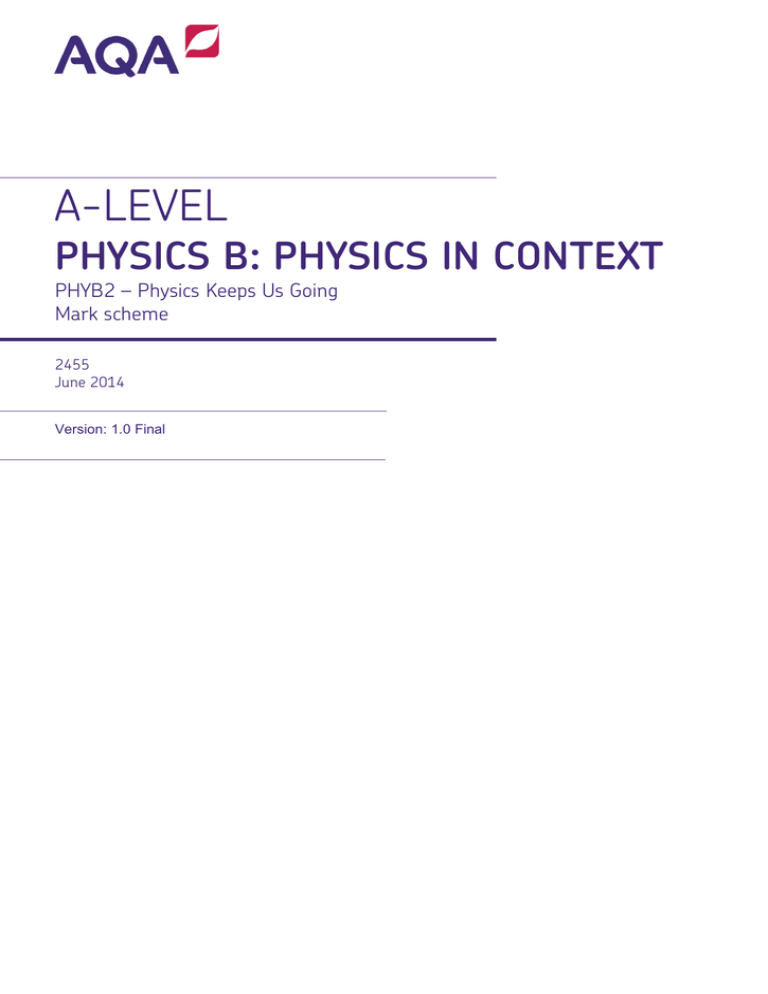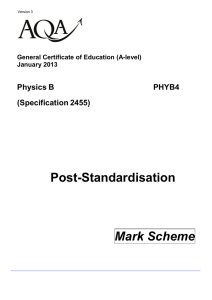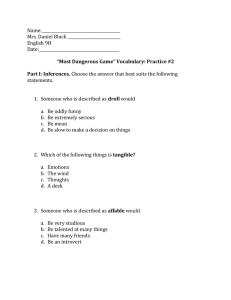
A-LEVEL
PHYSICS B: PHYSICS IN CONTEXT
PHYB2 – Physics Keeps Us Going
Mark scheme
2455
June 2014
Version: 1.0 Final
Mark schemes are prepared by the Lead Assessment Writer and considered, together with the
relevant questions, by a panel of subject teachers. This mark scheme includes any amendments
made at the standardisation events which all associates participate in and is the scheme which was
used by them in this examination. The standardisation process ensures that the mark scheme covers
the students’ responses to questions and that every associate understands and applies it in the same
correct way. As preparation for standardisation each associate analyses a number of students’
scripts: alternative answers not already covered by the mark scheme are discussed and legislated for.
If, after the standardisation process, associates encounter unusual answers which have not been
raised they are required to refer these to the Lead Assessment Writer.
It must be stressed that a mark scheme is a working document, in many cases further developed and
expanded on the basis of students’ reactions to a particular paper. Assumptions about future mark
schemes on the basis of one year’s document should be avoided; whilst the guiding principles of
assessment remain constant, details will change, depending on the content of a particular
examination paper.
Further copies of this Mark Scheme are available from aqa.org.uk
Copyright © 2014 AQA and its licensors. All rights reserved.
AQA retains the copyright on all its publications. However, registered schools/colleges for AQA are permitted to copy material from this
booklet for their own internal use, with the following important exception: AQA cannot give permission to schools/colleges to photocopy any
material that is acknowledged to a third party even for internal use within the centre.
MARK SCHEME – AS-Level Physics (B) – PHYB2 – June2014
COMPONENT NAME:
Unit 2 – Physics Keeps Us Going
COMPONENT NUMBER:
PHYB2
Question
Part
1
a
Sub
Part
Marking Guidance
Mark
Use of efficiency formula:
an output energy ÷ an input energy seen
or
6.8 −4.7
6.8
0.69(1)
1
or
2.1
6.8
or
5.1
6.8
or
4.7
5.1
C1
4.7 ×1012
6.8 ×1012
or 0.75 or 0.92 0r 75% or 92%
penalise 1 sf / penalise unit
b
2
1
Input (often) from electricity produced by non-renewable resources
Or
Input (often) from electricity produced by named non-renewable resource
Or
Energy to pump water is from non-renewable resource
A1
B1
Comments
Condone powers 10
error
Input must be 6.8 or
5.1
Allow 69 %
Must be clear about
Energy candidate is
referring to.
Could run out of
input energy
.....limiting case
3 of 13
MARK SCHEME – AS-Level Physics (B) – PHYB2 – June2014
1
c
2
Short start up time can meet surges in demand
Or
Produces a lot of energy quickly
1
B1
Condone minutes for
start up time
All accelerations are same
2
M1
Allow inference of
same magnitude.
Condone wrong
directions or opposite
signs for 1 mark
A1
All have an acc of
-2
9.81 ms scores two
marks
(Because) only force acting (on the ball) is weight / moving( freely) under
gravity /
-2
All have an acceleration of 9.81 m s
3
a
Floating object displaces (an amount of) fluid equal to its own weight
Or
For a floating object: upthrust = weight of object
1
B1
3
b
Decrease (not sinks) owtte
2
B1
more fluid to be displaced to produce larger upthrust to float
or
weight of the tanker is(now) greater than the (initial) upthrust
or
more fluid to be displaced to increase the weight of the displaced water (to equal
the increased weight of the tanker)
B1
Must refer to force(s)
acting
4 of 13
MARK SCHEME – AS-Level Physics (B) – PHYB2 – June2014
4
a
60⁄9.5 or 6.3 (litres) or 120⁄19
3
C1
Converts Wh to J or kWh to J
6.3 × 10 (kW) × 3600 or 6.3 x 10 x 30 x 60 (see 1.13 x 108 2marks)
Or 10 kWh =3.6 × 107 (J)
8
8
2.27 x 10 or 2.3 x 10
4
b
2
higher fuel consumption / more work done / More pollution / more CO2
production/ More SOX (NOX) / more CO2 production/ Increased acid rain /
Increased greenhouse effect
MAX
2
5
5
5
4
c
C1
Condone power 10
error
A1
ecf
For the same distance of journeys / per km
Condone power 10
error
A1
Use of P = ∆W / ∆ t
8
2.3 x 10 ÷ 1800 or 63 ÷0.5 or 63000 ÷0.5 or their ans (a) ÷1800 or
their answer to 4(a) ÷ a recognisable time (30 (min) / 0.5 (h))
1.26 x 10 or 1.26 x 10 or 1.3 x 10 (W)
C1
M1
More noise pollution
(1 mark)
Lower fuel
economy(without
explanation)
(1 mark)
Less efficient
(without explanation)
(1 mark)
1
5 of 13
MARK SCHEME – AS-Level Physics (B) – PHYB2 – June2014
5
a
identifies area of one square = 2 m / a recognizable formula / states that area
under graph is distance
2
B1
sectioning off
B1
ticks
33 (squares) / area of trapezium or triangle and rectangle with working only/
Attempt to find correct area
5
b
6
a
6
Straight line with positive gradient beginning at (3,0)
ends at 14 s
goes to (14,12)
3
M1
A1
A1
between 2.8 and 3.2
i
E / radiation
1
B1
General marker
a
ii
F / kinetic
1
B1
General marker
6
a
iii
C / rotational kinetic
1
B1
General marker
6
b
i
1
B1
turbines are rotated to face into wind /
Minimum distance between WTGs is maintained in all directions /
Each WTG is the Minimum distance (5d) from any other
6 of 13
MARK SCHEME – AS-Level Physics (B) – PHYB2 – June2014
6
b
ii
Use of P=1/2 πr ρv (condone error in sub for r) or finds radius = 82/2=41
2
Or finds area = 5281 (m )
2
3
Condone power of
10 error in sub for P
3
C1
3
Rearranges to make v subject condone incorrect sub for r (r = 82)
or makes v subject of correct equation incorrect sub for r
Correct powers of 10
C1
6
3
1.6 𝑥 10
or �1
2 seen
𝜋
×
1.2
×
41
2
8.0
6
c
A1
7
(b)
2
(i)
(ans v =5)
-1
More power available to a WTG / must increase spacing of WTGs
(a)
12674.4
or 7.96 (m s ) cao
2
no change (in power available per square metre of land)
7
1.6 𝑥 10 6
B1
Rate of heat loss through 1 m (of material) for 1 degree celsius temperature
difference (across the material)
Or
States formula with terms defined
1
From graph heat transfer is zero at 18°C
2
(Therefore) temperature difference (across wall) is zero /
( therefore) temperatures are same (inside and out)
B1
B1
Or energy transfer
for heat
Limiting case is
-2 -1
W m K in words
including power
B1
Reference to graph:
extrapolation
B1
7 of 13
MARK SCHEME – AS-Level Physics (B) – PHYB2 – June2014
7
(b)
(ii)
2
(Area of brick =) 6.4 x 2.5 – 7.5 or 8.5 (m )
Or temp diff = 18-6 or 12 (K)
3
C1
91.8 seen = 2 marks
C1
Use of U-value formula
condone 𝜃 = 6 or A = 6.4 × 2.5 in substitution
345.6 seen = 2
marks
A1
180 / 183.6 / 184 (W)
7
(b)
(iii)
(Finds heat loss through window = 640 − 184= 456
-2
-1
5.07 or 5.1 (W m K )
allow ecf
ecf
2
C1
Or subtracts b(i)
from their incorrect
read off of 680 or
620 (1 mark)
=4.8 error
A1
3.3 ecf, 6.1 ecf
8 of 13
MARK SCHEME – AS-Level Physics (B) – PHYB2 – June2014
8
(a)
Use of potential divider formula
condone R1 , R2 mix up
Correct sub into formula
condone R1 , R2 mix up
3
C1
correct powers of 10
C1
( V= I × R =)
2.05 or 2.1 (V)
(b)
condone powers of
10 error
A1
2.05 or 2.1 (V)
Or
(I =) 12 / 5550
8
C1
12
5550
× 950 or
12
5550
× 4600
Resistance decreases
C1
condone powers of
10 error
correct powers of 10
A1
3
B1
B1
Increased number of free electrons / more vibration of lattice / more free
electrons / increased amplitude of vibration
B1
Allow charge carriers
2
C1
A1
PE equations of
motion
2
C1
A1
More vibration should increase resistance but more free electrons decreases
resistance and this is dominant effect
9
(a)
9
(b)
Use of ke = ½ m v
14.7 / 15 (m)
(i)
2
2
or sets mgh = ½ m v and makes h subject
Calculates the change in velocity (a× 𝑡) seen
-1
v = 15.7 / 16 (m s )
9 of 13
MARK SCHEME – AS-Level Physics (B) – PHYB2 – June2014
9
(b)
(ii)
Use of pythagoras' theorem:
ecf
2
2
2
res vel = 15.7 + 17 o r res vel = √ 𝑥 2 + 172
2
-1
23 or 23.1 or 23.3 (m s ) ecf
9
(c)
28° or 62° seen( inside right angled triangle)
-1
13 or 12.7 (m s )
2
C1
-1
A1
36.85, 37 ms ecf
C1
Calculated 25 in
correct position
on diagram
Or 25 + 37
A1
10 of 13
MARK SCHEME – AS-Level Physics (B) – PHYB2 – June2014
9
(d)
6
Level 5-6
slope: smaller change in vertical component of velocity
smaller change in vertical component of momentum
Technique: increases time for (same) momentum
𝐹=
∆ 𝑚𝑣
∆𝑡
B1
B1
B1
B1
B1
B1
Faultless use of
technical terms
Must mention slope
and technique
is quoted (allow in words) and applied properly to
either slope or technique
or
∆𝑣
𝐹 = 𝑚 𝑎 and 𝑎 =
are quoted and applied properly to
∆𝑡
either slope or technique
or
𝑊
𝐹=
is quoted and applied properly to
𝑠
either slope or technique
level 3-4
smaller change in velocity on slope (compared to horizontal)
smaller change in momentum on slope (compared to
horizontal)
increases time
reduces speed more gradually
work done over bigger distance
level 1-2
decreases force (therefore less risk of injury)
bends knees
bending knees absorbs energy
Maximum of 4 for
only slope or
technique
Good use of
technical terms
Poor use of technical
terms
11 of 13
MARK SCHEME – AS-Level Physics (B) – PHYB2 – June2014
10
(a)
connects ammeter in series with cell and load resistor (any resistive load)
2
Includes rheostat or other practicable means of obtaining range of data and
voltmeter in parallel
10
(b)
Work done in moving unit charge or energy per coulomb or energy per unit
charge or states formula and defines terms or joules per coulomb
B1
Penalise extra
incorrect meters /
connecting wires/
resistors
B1
2
B1
Treat mention of
force as neutral
B1
(Whole way) round circuit
10
(c)
2.8 (V)
Read off of V= 0 when I = 2.2 A or other point on line: (0.6,2) , (1.4,1)
10
(d)
(i)
Use of ε = IR + Ir
ecf for emf and approx read off
1.27 to 1.29 , 1.3 maximum (Ω)
penalise minus sign on answer
parallel
Total emf unchanged / internal resistance of combination decreased /
Two resistors in parallel therefore lower (by formula e.g.)
1
3
2
B1
C1
Attempts to find
gradient
C1
gradient = (-) r
A1
no ecf on answer
M1
A1
12 of 13
MARK SCHEME – AS-Level Physics (B) – PHYB2 – June2014
10
(d)
(ii)
Last longer
More energy stored in combination
2
B1
B1
One cell
"runs down "or is
faulty circuit still
works (1 mark)
Or
Brighter / more efficient / more current / more power to bulb
1 mark statement
1 mark explanation
Combination has smaller internal resistance / less lost volts / larger terminal pd
13 of 13





